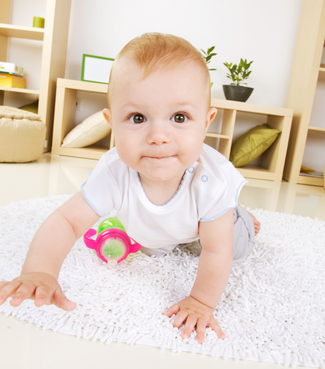After a few years of living as a couple with no kids, your home might be a fantastic place to entertain friends but not so safe for little ones cruising around. Babyproofing your home ensures your little kid won’t get into dangerous situations. To avoid becoming overwhelmed by the extent of the modifications you need to make, take things room by room to transform your house into a baby-friendly home.

Create a Safe Crib Space
For the first months of your little one’s life, she’s going to be spending a lot of time in the nursery. The Consumer Product Safety Commission recommends purchasing a new crib or getting one less than 10 years old. Make the interior as bare as possible. Do not add thick quilts, pillows, extra padding or bumper to a crib. Those additions can increase a baby’s risk of suffocation or sudden infant death syndrome (SIDS). Also remember to check around the sides of the crib and the mattress, making sure there are no gaps greater than two fingers in width.
Change the Blinds
Even the blinds on your windows can pose a safety risk for children. Infants and toddlers sometimes get the cords of window blinds wrapped around their necks, causing strangulation. For a safer solution that still looks chic, get rid of those Venetian blinds in favor of cordless roller shades, which block light without posing a hazard to children.
Watch the Stairs
As soon as your little one begins to crawl, it’s essential to take appropriate precautions to prevent accidents on stairs. Install gates with plastic meshwork or vertical slats onto the top and bottom of each staircase. Avoid the older, accordion-style gates, which can collapse and cause falling hazards. If you want to give your baby some practice navigating stairs, consider moving the bottom gate up two or three steps. However, it’s important to always supervise attempts at climbing stairs to ensure your kiddo doesn’t hurt himself.
Crawl Around to Look at Dangerous Objects
As an adult, it’s tough to think of every little thing that could pose a risk to your child. When you’re babyproofing, try crawling around your house to see what risks are within grasp of your child. For example, remove all pet dishes from the floors or relocate them to areas that your child can’t get to. Similarly, certain common houseplants that can be irritating or toxic to young children. The University of Connecticut Cooperative Extension system maintains a list of plants that may be harmful to kids. Move amaryllis, calla lilies, azaleas, ranunculus and daffodils to a shelf or high place to ensure your child remains safe. Also remember to move extension cords out of the reach of children; many babies are tempted to gnaw on cords, which can pose electrical dangers.
Knickknacks
Perhaps you’ve filled your home with interesting things you’ve picked up from garage sales or thrift stores over the years. However, many knickknacks pose choking hazards for kids. If you have objects that you simply must display, consider running a high shelf along the walls of your living room to show off your favorites.
Courtesy of BlueFirePR.





Add A Comment
Thank you for your comment.
Sorry! There was a problem with your comment submission. Please try again.
Comment
Allowed HTML: <b>, <i>, <u>, <a>
Comments
Thank you for your comment.
Sorry! There was a problem with your comment submission. Please try again.
Thank you for your comment.
Sorry! There was a problem with your comment submission. Please try again.